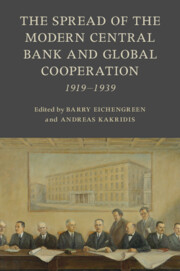Book contents
- The Spread of the Modern Central Bank and Global Cooperation
- Studies in Macroeconomic History
- The Spread of the Modern Central Bank and Global Cooperation
- Copyright page
- Contents
- Figures
- Tables
- Editors and Contributors
- Preface
- Part I General
- Part II Specific
- 5 Central Bank Policy under Foreign Control
- 6 Sneaking Nationalization
- 7 The Bank of Poland and Monetary Policy during the Interwar Period
- 8 From Banking Office to National Bank
- 9 ‘Nobody’s Child’
- 10 The Bulgarian National Bank, 1926–1935
- 11 Macroeconomic Policies and the New Central Bank in Turkey, 1929–1939
- 12 Latin American Experiments in Central Banking at the Onset of the Great Depression
- 13 Central Banks in the British Dominions in the Interwar Period
- 14 Central Banking and Colonial Control
- Index
- References
6 - Sneaking Nationalization
Hungary and the Liberal Monetary Order, 1924–1931
from Part II - Specific
Published online by Cambridge University Press: 02 November 2023
- The Spread of the Modern Central Bank and Global Cooperation
- Studies in Macroeconomic History
- The Spread of the Modern Central Bank and Global Cooperation
- Copyright page
- Contents
- Figures
- Tables
- Editors and Contributors
- Preface
- Part I General
- Part II Specific
- 5 Central Bank Policy under Foreign Control
- 6 Sneaking Nationalization
- 7 The Bank of Poland and Monetary Policy during the Interwar Period
- 8 From Banking Office to National Bank
- 9 ‘Nobody’s Child’
- 10 The Bulgarian National Bank, 1926–1935
- 11 Macroeconomic Policies and the New Central Bank in Turkey, 1929–1939
- 12 Latin American Experiments in Central Banking at the Onset of the Great Depression
- 13 Central Banks in the British Dominions in the Interwar Period
- 14 Central Banking and Colonial Control
- Index
- References
Summary
This chapter challenges the conventional chronology of the interwar era that distinguishes the conservative 1920s, when policy makers were preoccupied with the restoration of the pre-First World War liberal economic order, and the revolutionary 1930s, when they reacted to the global economic and financial crisis by pursuing isolationism, state interventionism, and trade blocs. Taking the example of Hungary’s monetary management in the 1920s, it shows that there was more continuity between the two decades than is usually recognized. Due to the dislocations arising in the wake of the war and subsequent peace arrangements, the fragmentation of empires into small ethnonationalist states, and revolutionary and counterrevolutionary political and social upheavals, institutional and policy adjustments in the direction of what was to become mainstream in the 1930s were already budding in the 1920s. The chapter provides empirical evidence of this sneaking nationalization in Hungary’s monetary management, manifest in a combination of adherence to the rules of the gold standard game, on the one hand, and capital-flow neutralization, on the other, depending on what was appropriate to stimulate or sustain domestic economic activity.
Keywords
- Type
- Chapter
- Information
- The Spread of the Modern Central Bank and Global Cooperation1919–1939, pp. 139 - 159Publisher: Cambridge University PressPrint publication year: 2023



